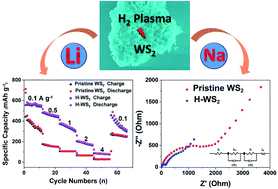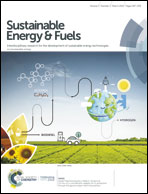Disordered surface formation of WS2via hydrogen plasma with enhanced anode performances for lithium and sodium ion batteries†
Abstract
Transition metal dichalcogenide (TMD) nanoparticles have attracted much attention recently for lithium and sodium ion batteries (LIBs and SIBs) due to their layered structures, which act as host lattices when reacting with ions to yield intercalation compounds. In the present article, WS2 nanoparticles are modified through hydrogen plasma treatment, and the hydrogenated WS2 (H-WS2) nanoparticles demonstrate clearly enhanced electrochemical performance as an anode material for LIBs and SIBs. H-WS2 nanoparticles are fabricated via hydrogen plasma treatment at 300 °C for 2 hours. A transmission electron microscopy (TEM) investigation shows that the nanoparticles have a disordered surface layer with a thickness of around 2.5 nm after the treatment, and this is confirmed by the results of Raman spectroscopy. A shift in the X-ray photoelectron spectroscopy (XPS) peaks indicates that the structural surface disorders are incorporated in the crystalline structure. The H-WS2 based LIBs and SIBs possess significantly higher specific capacities at different current densities. In addition, electrochemical impedance spectroscopy (EIS) reveals a drastic decrease in the charge-transfer resistance for both the LIBs and SIBs, which implies that the plasma hydrogenated electrode is more favorable for electron transportation during the electrochemical process. The improved rate performance of H-WS2 when applied to both LIBs and SIBs can be attributed to the reduced charge-transfer resistivity at the disordered surface layer and the improved electronic conductivity due to the disordered surface in the crystalline structure.



 Please wait while we load your content...
Please wait while we load your content...